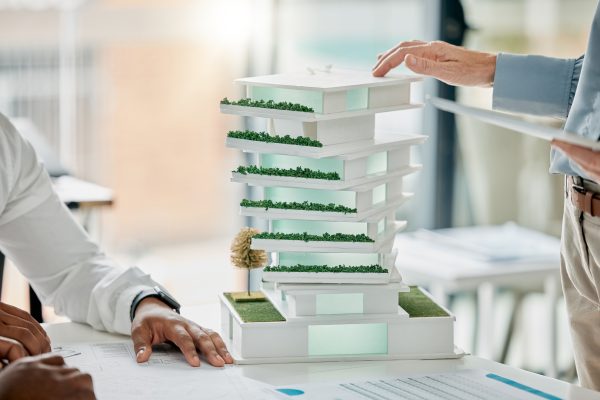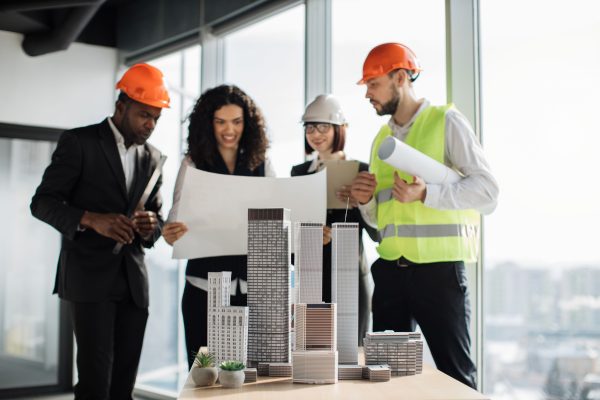Innovations in building design continually redefine our lifestyles, work environments, and interaction with the world around us. The projection from The Business Research Company’s Green Building Materials Global Market Report 2024 anticipates the global market for green building materials to surge to $490.8 billion by 2028. With an increased focus on sustainability and fueled by technological progress, architects and designers are certainly pushing the limits of what’s possible in the built environment. In this blog, we delve into the latest trends in innovative materials and technologies shaping the future of building design.
Sustainable Building Materials in Building Design

Sustainability has evolved from being a mere buzzword to a fundamental guiding principle in contemporary building design. Architects and designers are increasingly focusing on eco-friendly materials. They not only minimize environmental impact but also make the most performance across various parameters.
Engineered wood, recycled steel, and sustainable concrete alternatives have emerged as favored choices. They have low carbon footprint and renewable characteristics. These materials are gaining traction not only for their eco-friendly attributes but also for their ability to create healthier indoor environments. Thus, by opting for sustainable materials, architects can significantly reduce energy consumption during the production phase.
Moreover, these materials contribute to improved indoor air quality, as they often emit fewer unpredictable organic compounds (VOCs) compared to their conventional counterparts. As the demand for sustainable building practices continues to grow, architects and designers are discovering innovative ways to integrate eco-friendly materials into their projects. By doing so, they pave the way for a greener and more sustainable built environment.
Building Design Smart Building Systems
The integration of smart technologies marks a pivotal shift in the realm of building design. It propels traditional structures into the realm of intelligent, adaptable environments. Architects and building designers are increasingly leveraging a suite of smart building solutions. For instance, there are automated lighting, HVAC (heating, ventilation, and air conditioning) systems and sophisticated building management platforms. These smart building systems are designed to improve energy efficiency, enhance comfort, and improve overall operational performance.
IoT

At the core of this transformation is the Internet of Things (IoT) and data analytics. By using the power of interconnected sensors, devices, and systems, buildings can now adapt and respond to changing conditions in real time. For instance, sensors inserted within building systems can monitor factors such as occupancy levels, temperature, and lighting conditions. These consequently allow for dynamic adjustments to be made automatically. Furthermore, this real-time responsiveness not only enhances the comfort and well-being of building occupants. The building design with IoT also leads to significant energy savings and cost reductions.
Moreover, building designs with smart building technologies enable predictive maintenance and proactive management of building systems. By constantly monitoring equipment performance and seeing potential issues before they escalate, building managers can save time and costs and extend the lifespan of critical building assets.
Data Analytics Tools
Additionally, data analytics tools provide valuable insights into building performance, allowing stakeholders to identify trends, optimize resource allocation, and make data-driven decisions to drive continuous improvement.
The integration of smart technologies is changing building design, construction, and operation. As these technologies become more accessible and affordable, the adoption of smart building solutions is expected to go on, leading to greater sustainability, efficiency, and resilience in the built environment. Ultimately, smart technologies in building design promise to create more intelligent, responsive, and user-centric spaces that meet the evolving needs of occupants and stakeholders alike.
Modular Construction
Modular construction stands as a disruptive force in the realm of building design and construction. It offers a swift and cost-effective alternative to traditional methods. This forward-thinking method entails manufacturing building components off-site within controlled factory settings, followed by transportation and assembly at their on-site location. The result is a streamlined construction process characterized by reduced timeframes, minimized disruption to surrounding areas, and significant savings in labor costs.
Accelerate Project Timelines
One of the key advantages of modular construction lies in its ability to accelerate project timelines. By manufacturing building modules concurrently with on-site groundwork, construction schedules can be compressed dramatically. Pre-made modules arrive at the construction site ready for installation, eliminating the need for time-consuming on-site fabrication and assembly. This shortened construction period not only reduces project duration but also mitigates the risks associated with weather delays and site-specific challenges, ensuring timely project completion.
Cost-Efficient
Moreover, modular construction offers inherent cost efficiencies compared to traditional building methods. The controlled factory environment allows for greater precision and quality control during the manufacturing process, minimizing material waste and rework. Additionally, the assembly-line production of building components enables economies of scale, driving down production costs and improving overall project affordability. As a result, modular construction projects often boast lower overall construction costs. Additionally, it improves budget predictability of the building design compared to their conventionally built counterparts.
Flexibility in Design
Furthermore, modular construction provides architects and designers with design flexibility and more customization options. The modular nature of the building components allows for easy application of various architectural styles, finishes, and changes. This enables designers to create innovative and unique structures tailored to the specific requirements of their clients. From residential dwellings and commercial buildings to healthcare facilities and educational institutions, modular construction can accommodate a wide range of architectural visions and functional needs.
Sustainability Benefits
In addition to its speed, cost-effectiveness, and design versatility, modular construction is also recognized for its sustainability benefits. The controlled factory environment promotes resource efficiency and waste reduction. Additionally, the ability to reuse and repurpose modules contributes to a more circular approach to construction. Furthermore, the modular construction process generates less on-site disturbance and noise pollution, minimizing the environmental impact on surrounding communities.
Biophilic Building Design
Biophilic design integrates natural elements and patterns into the built environment. From living walls and green roofs to daylighting and natural ventilation strategies, biophilic design elements enhance occupant well-being, productivity, and satisfaction. Additionally, by blurring the lines between indoor and outdoor spaces, biophilic design fosters a deeper connection to the natural world. It promotes health and happiness in built environments.
High-Performance Building Envelopes
Building envelopes play a crucial role in regulating indoor climate conditions and reducing energy consumption. Moreover, advances in materials science and building technology have led to the development of high-performance building envelopes. These offer superior thermal insulation, air tightness, and moisture control. From triple-glazed windows and insulated concrete panels to advanced cladding systems, these innovations enhance building efficiency, comfort, and durability without a doubt.
Conclusion

The demands on the built environment continue to evolve. Therefore, architects and designers must embrace innovation to create buildings that are also sustainable, resilient, and responsive to the needs of occupants and the environment. By leveraging the latest materials and technologies, we can have a built environment that enhances the quality of life for generations to come.
Ready to innovate and elevate your architectural projects? Partner with BizForce and gain access to our team of expert architects and designers who can help bring your vision to life. Whether you’re seeking to incorporate cutting-edge materials, implement sustainable design practices, or enhance occupant comfort and well-being, we’ve got you covered. Together, let’s create buildings that redefine the standards of functionality, aesthetics, and sustainability. Contact us here.
